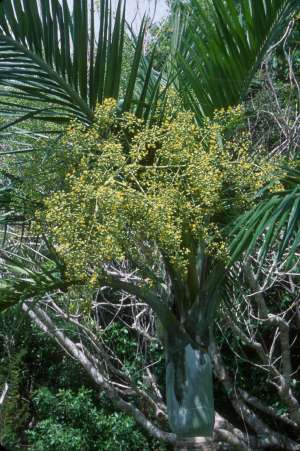Plants of South Florida · Plants by Conservation Area · Plants by County · Plants by Habitat Quick Search · Advanced Search |
||
|
|
||
 |
Pseudophoenix sargentii H.Wendl. ex Sarg. Sargent''s palm, Sargent''s cherry palm |
|
|
South Florida Status: Critically imperiled. One occurrence at Biscayne National Park. Taxonomy: Monocotyledon; Arecaceae. Habit: Tree. Distribution: Native to South Florida, the West Indies, Mexico, and Central America. South Florida Distribution: Miami-Dade County and the Monroe County Keys. South Florida Habitats: Rockland hammocks and coastal berms. Protection Status: Listed as endangered by FDACS and as critically imperiled by FNAI. Aids to Identification: Pseudophoenix is one of two native palm genera having pinnate leaves, the other genus being Roystonea. Pseudophoenix is distinguished from Roystonea in being of much smaller stature, and by having an inflorescence that emerges from among the leaves rather than below it (Wunderlin, 1998). Scurlock (1987) has color photos. References: Small, 1933a; Ledin et al., 1959; Read, 1968; Long & Lakela, 1976; Ward, 1976; Little, 1978; Scurlock, 1987; Lippincott, 1992a; Nelson, 1994; Lippincott, 1995; Wunderlin, 1998, Coile, 2000; Flora of North America Editorial Committee, 2000. Synonyms: P. vinifera (Mart.) Becc., misapplied. Historical Context: Commodore Ralph Munroe discovered Sargent’s cherry palm in 1886 on Long Key in Monroe County (Munroe, 1930; Read, 1968), and Allan H. Curtiss vouchered it there in 1896 (5637, GH, NY, US). Also in 1886, Charles S. Sargent and Allan H. Curtiss discovered it on Elliott Key in Miami-Dade County (s.n., NY), where a total of six individuals were observed (Read, 1968). In 1923, a single tree was found on Sands Key by Wirth Munroe, which was vouchered by John Kunkel Small and John B. DeWinkeler (10770, GH; Ledin et al. 1959; Read, 1968). Excellent and detailed histories of the species in South Florida are provided by Ledin et al. (1959), Read (1968), and Lippincott (1992a, 1995). As reported by Read, as many as 200 individuals were found at a single time on Long Key and as many as 150 on Elliott Key. John Kunkel Small (1922) reported Sargent’s cherry palm from Upper Matecumbe Key, but the plants were transplants from Long Key. A photograph taken by Clifton Adams in the herbarium of the Smithsonian Institution shows a single mature plant surrounded by native vegetation on Lower Matecumbe Key. A letter accompanying the photograph was written by David Fairchild to O.F. Cook. The letter described the photograph as having been taken in 1931, and indicates that Fairchild also saw the plant. We have not seen a discussion of this station elsewhere (e.g. Read, 1968), and cannot be certain that it was not a cultivated plant. Unfortunately, Sargent’s cherry palm became highly desirable as a landscape plant and plant collectors plundered the populations on Elliott Key and Long Key (Lippincott, 1992a). Other plants were destroyed on Elliott Key by settlers clearing land for pineapples and other fruit crops (Lippincott, 1992a). By 1966, George N. Avery was unable to locate any plants on Long Key, where he had previously found the species (Botanical Notes of George N. Avery, 1 August 1966). A subsequent survey in 1990 by Fairchild Tropical Garden biologist Carol Lippincott and Florida Park Service biologist James G. Duquesnel was also in vain (Lippincott, 1992a). While plants on Long Key were extirpated, a small population persisted on Elliott Key. Surveys by Biscayne National Park staff in the 1970s and 1980s resulted in the location of 29 plants (Lippincott, 1992a). By 1990, additional surveys by the staffs of the National Park Service, Fairchild Tropical Garden, and the Florida Park Service had recorded 47 plants (Lippincott, 1992a). In August 1992 Hurricane Andrew killed 19 of the tallest plants on Elliott Key (Lippincott, 1995), reducing the population to 28 plants. Fairchild Tropical Garden maintains a collection of germplasm from South Florida, and has done extensive horticultural work on this species. In addition, Fairchild has worked with the National Park Service and the Florida Park Service to augment the population on Elliott Key and reintroduce a population on Long Key. Lippincott (1992a, 1995) gives excellent accounts of these translocation efforts. Fairchild Tropical Garden and Florida Park Service staffs continue to map and monitor both wild and translocated plants at both sites. Major Threats: Poaching; exotic pest plant invasions. Comments: An unpublished paper written by R. Bruce Ledin disputes the nativity of this species. We have seen no evidence to suggest that Sargent’s cherry palm was introduced. Recommendations: • Continue mapping and monitoring of wild plants on Elliott Key. • Continue augmentation project on Elliott Key. • Continue reintroduction project on Long Key. |
||



